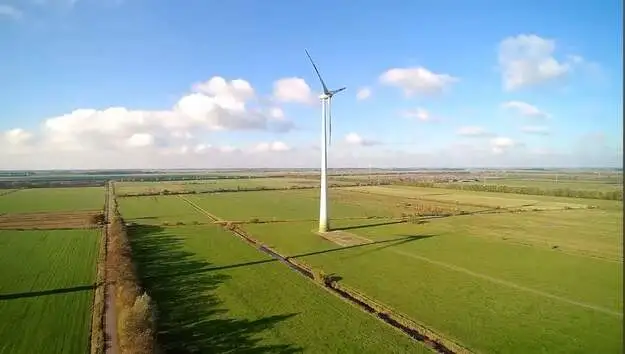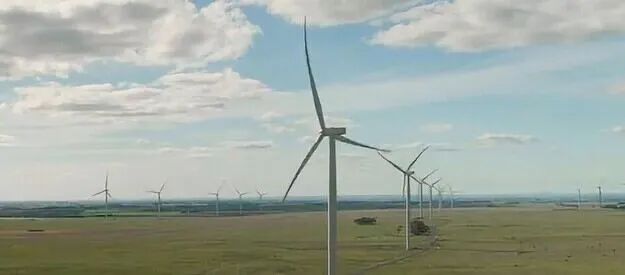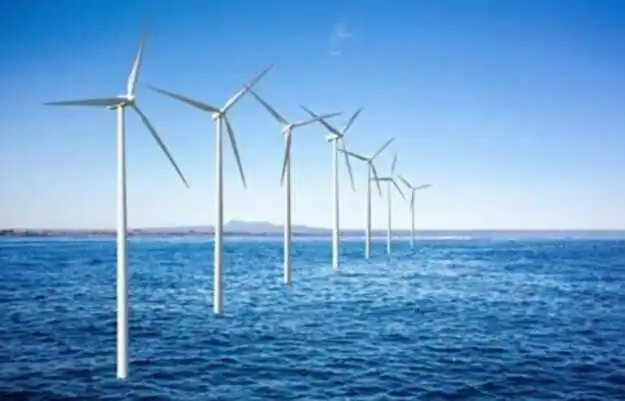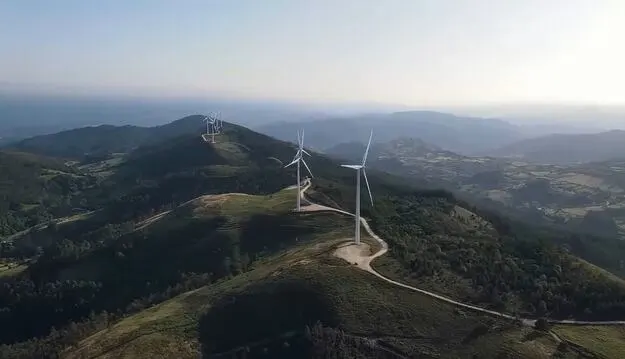Wind Power Plant in India: benefits
Table of Contents
ToggleAs the world’s second-most populous country, India is stepping up its use of green energy to tackle its soaring demand for power. With the environment concerns, worsening pollution and other environmental problems that conventional energy sources have caused; India has taken significant steps in the increase of renewable energy especially wind energy. In this article you can get the whole information regarding wind power plant in India, its current status, challenges and future prospects.
What is Wind Power Plant in India

Wind power is a clean and renewable source of energy that generates electric power by taking the kinetic energy created by moving air masses to turbine and converting it into electrical power.
It is not harmful to the environment, and it is also quite helpful in reducing the overall carbon emissions.
With the increasing need for energy in India, wind energy presents a reliable option whose use is a good step taken for the energy security of the country.
History of Wind Power Plant in India
Development of wind energy plants in India began in the 1980s. Muppandal in Tamil Nadu was chosen to set up the first wind power plant, which was commissioned in 1986.
This marked the future of wind energy in India, which has grown rapidly, driven by systematic planning by both the government and private enterprises.
During the 1990s, few policies and projects were implemented to develop wind energy, leading way to an organized sector.
First Wind Power Plant in India
The first wind energy production in India was done in 1986 in Mundramalai, Tamil Nadu state. This wind turbine technology was built in collaboration with the National Institute of Wind Energy (NIWE).
Tamil Nadu is the leading state in wind power generation in india. The Indian government launched renewable energy sources schemes in the 1990s with the main objective of promoting wind energy.
Wind Power Plant Working Principle
How does a wind power plant work – The wind power plant operates on the principle of there is converting kinetic wind energy into electrical energy.
The source of the wind energy in a wind turbine is the rotor which spins when air flows through it. We will learn in detail about the working principle of wind energy plant.
1. Kinetic Energy of Wind
A wind power plant has the first stage — kinetic wind energy usage, Movement of air or wind is harnessed using wind turbines. It is the energy of the wind, kinetic energy.
2. Operation of Wind Turbines
There are mainly four parts of wind power plant, Each part of them has very importance in operation of wind power plant.
Blade
The blades from a wind turbine only spins with the wind. Its blades are designed so that they can take full of the energy from the wind because they are aerodynamically design.
Rotor
This rotation of the blades rotates a rotor. The rotor is connected to the blades and serves as a rotational center for the turbine.
3. Conversion of energy
Gearbox
The gearbox transmits the velocity of the rotor to the electric generator. With the aid of the gearbox, the speed of rotation made by the rotor is increased so that it attains the required speed reaching the generator.
Generator
The gearbox multiplies motion, which comes into the generator. The generator converts this rotating motion into electrical energy. This electrical energy is produced as AC (alternating current).
4. Energy Transmission
Nacal
This is the upper part of the wind turbine that contains the gearbox, generator, and other controlling devices.
Tower
This in turn, allows the wind turbine to capture more of the oncoming wind due to the height available from the tower.
Transformers and grids
The produced electrical energy is transformed into the desired voltage using a transformer and then transmitted to an electrical grid. From here, this energy reaches manifold users.
5. Control System
Wind turbines control both the speed and direction of the turbine. The system does this by keeping track of the wind speed and direction and adjusting the turbine’s position for maximum energy production.
6. Safety Measures
Wind turbines have safety features to shut off in high winds or other hazardous conditions. This might prevent damage to the turbine.
Types of Wind Power Plant
There are several different types of wind power plants concerning design and operation. Herein, some major types of wind power generation in India are described.
1. Land Based Wind Energy Plants (Onshore Wind Power Plants)

These wind power project in india are installed on land and are usually found in rural or remote areas where the wind speed is high. These plants have the following characteristics.
- Installation and maintenance of land-based wind turbines are relatively straightforward.
- These have far lower installation costs compared to offshore wind power plants.
- These plants can harness more energy if installed in areas with more significant winds.
2. Marine Wind Power Plant (Offshore Wind Power Plant)

Installed offshore wind energy plants are located in the ocean, away from coastal areas.The first offshore wind power plant in India is located off the Gujarat coast of the Arabian Sea. Their main characteristics are discussed below.
- This is attributed to the fact that at sea, the wind speed and stability are higher. Hence, it allows more energy to be generated.
- Such plants are associated with less noise and visual effects, thus environmentally friendly.
- Installing and maintenance of offshore wind turbines are costlier, but they generate more energy.
3. Coastal Wind Power Plant ( Nearshore Wind Power Plant )
These wind energy plants in India are located near the coast, and are a mixture of marine and land-based plants. Their features are.
- That means wind speed in coastal areas is moderate, which would ensure stable energy generation.
- These plants are also less expensive than marine plants and are low in maintenance.
4. Distributed Wind Energy System
They could be wind power plants installed at small scale by individual homes, small business enterprises, or even by small communities. The first commercially viable distributed wind power project in india were introduced in Tamil Nadu, Maharashtra, and Gujarat. Their features include.
- This system reduces dependence on the grid for energy generation.
- It utilizes small wind generators capable of meeting local requirements.
- The energy generated is used locally and thus reduces losses of power.
5. Hybrid wind energy system
Hybrid systems combine wind power in India with other forms of renewable energy, such as solar energy. Their features include:.
- Combining a few kinds of energy sources ensures high and stable production.
- This system diversifies energy production and reduces dependence on a single source.
- A hybrid system is more reliable because it uses different energy sources.
Power Coefficient of Wind Turbine
One of the most important parameters to measure efficiency could thus be called a power coefficient, also known as C_{p} .
It is defined as that fraction of the wind turbine that will ever be able to convert into electrical energy out of the total available energy in the wind.
Therefore, the value of the power coefficient may be anything between 0 and 1; for practical turbines, however, it usually remains less than 0.59 (59%). This limit is also called the Betz limit.
Calculating the Power Coefficient
The power coefficient, C_{P} , is given by
C_{p} = P_{t}/P_{w}
Where
P_{t} = Power generated by the wind turbine (in watts)
P_{w} = Total power available in the air (in watts)
Calculating the Total Power Available in The Air
The total power available in the air (P_{w}) is calculated by the following formula.
P_{w} = \dfrac{1}{2} . ρ . A . V^3
Where
ρ = density of air (kg/m³)
A = area swept by the turbine blade (m²)
V = wind speed (m/s)
Importance of Power Coefficient
- The power coefficient quantifies how much wind energy is converted by a wind turbine into electrical energy. Larger C_{p} means higher efficiency of the turbines.
- C_{p} is used to optimize the design of turbines so that they can achieve the highest efficiency at different wind speeds.
- C_{p} is used to compare the performance of different wind turbines.
Betz Limit
It is according to the theory laid down by Albert Betz only a maximum of 59.3% of the energy available in the wind can be captured by any wind turbine.
This is the limit due to natural and physical limitations. The Betz limit makes sure no wind turbine is capable of completely stopping the flow of air since the air needs to pass on through the turbine.
Practical Power Coefficient
Practical wind turbines usually have CP starting from 0.3 to a maximum of 0.45, depending on their design and operating conditions.
This of course is less than the Betz limit; however, recent technological improvements and better designs can still enhance this value.
What are the uses of Wind Power
Wind energy is such an important renewable energy source used in different sectors. Its uses promote environmental benefits and energy security. The main uses of wind energy are hereby described.
1. Electricity Generation
- The primary application of wind power in India is electricity generation at a large utility-scale. Electricity generated from Wind Power Plants is fed into the national or regional electricity grid, from where it gets distributed to homes, industries, and businesses.
- In areas where there is no grid and in remote/rural regions, wind turbines can meet local electricity demands.
2. Industrial Use
- Because many industries demand high energy, wind power project in India can offer clean, renewable energy to provide them at a lesser cost without damaging the environment.
- Maritime wind power plants may be used to supply energy to offshore oil-and-gas drilling platforms.
3. Household Use
- An individual wind turbine has the potential, if harnessed as clean energy, to run a few homes and thus reduce an electrical house bill, generally reducing dependence on fossil fuels.
- In this direction, wind power in India can be used to run hot water heating systems and other space heating needs of houses.
4. Agriculture and Rural Use
- These wind turbines can be used to pump water in fields for irrigation, and other agricultural equipment.
- Wind power in India could become one of the primary supplies of clean, reliable electricity to areas where conventional grid access is a problem.
5. Transportation
- In the future, the share of renewable energy in the transport sector in India can be further increased by siting wind power at electric vehicle charging stations.
- Wind energy plants in india can be hybridized with solar power and other renewables to provide a more stable energy supply.
6. Environmental Benefits
- Wind energy can be used in place of fossil fuels, reducing greenhouse gas emissions and helping to combat climate change.
- Construction and operation of wind power generation in India are therefore, environment-friendly since they reduce water pollution, air pollution, and the use of natural resources.
7. Economic Benefits
- Wind energy projects provide local employment. Various human resources are required for the installation, operation, and maintenance of such projects.
- Wind power in India projects have economic benefits to the local communities since these projects promote regional development. .
8. Research and Development
- Research and development in the wind energy sector leads to the development of new technologies and innovations, which improve the efficiency and cost-effectiveness of wind energy.
- Thus, the educational programs and research projects on wind power in India are beneficial to students and scientists for learning and gaining experience.
Advantages of Wind Power
Wind energy plants in india is an important renewable energy source that is used in various sectors. It has many advantages that make it an attractive option for energy production. The major advantages of wind energy are described below.
1. Eco-Friendly
- There are no greenhouse gases emitted when producing wind power in india, making it no contributor to climate change.
- Wind energy plants do not cause air and water pollution, thus they do not harm the environment.
2. Renewable and Sustainable Sources
- Wind is a renewable resource that never runs out. It is always available, allowing energy production to continue uninterrupted.
- The use of wind energy promotes sustainable development, as it conserves natural resources and ensures availability of energy for future generations.
3. Energy Security
- The use of wind power in India can reduce dependence on fossil fuel imports, thereby increasing energy security.
- Wind power in india can be generated locally, increasing energy self-sufficiency.
4. Economic Benefits
- Wind power in india projects create local employment opportunities. These include construction, operation, and maintenance.
- Wind energy projects provide economic benefits to local communities, promoting regional development.
5. Technological Advancement
- Research and development in the wind energy sector leads to the development of new technologies and innovations, improving the efficiency and cost-effectiveness of energy production.
- Educational programs and research projects based on wind energy help students and scientists to gain knowledge and experience in this field.
6. Low Operation and Maintenance Cost
- Once a wind power plant is installed, its operation and maintenance costs are relatively low, leading to long-term cost savings.
- Wind turbines are simple and less expensive to maintain compared to other energy generation systems.
7. Effective Use of Land
- Wind turbines can be installed on agricultural land, allowing the land to be used for agriculture and energy production at the same time.
- Relatively little land is required to install a wind turbine, ensuring maximum land utilisation.
8. Compatibility with Other Sources of Energy
- Wind energy can be combined with solar energy and other renewable sources to create hybrid energy systems, providing more stable and reliable energy.
- By combining wind energy with modern energy storage technologies, continuous and uninterrupted energy supply can be ensured.
Disadvantages of Wind Power Plant
Though wind energy has many advantages, it also has some disadvantages that must be considered.
These disadvantages pose some challenges in installing and operating a wind power generation in India. Some significant disadvantages of wind energy are described below.
1. Unreliability and Uncertainty
- Finally, wind energy is dependent on the speed and direction of wind, which naturally are unpredictable. This therefore, causes instability in the power produced because of the unstable or variable winds.
- It becomes hard to offer a continuous energy supply because the energy produced by wind turbines is decreased when the wind speeds decreases.
2. High Initial Cost
- Setting up a wind power plant is very expensive, especially for the turbine, tower, and other equipment.
- It is also an expensive affair to establish the supporting infrastructure of a wind power plant in terms of roads, transmission lines, and grid connections.
3. Spatial Requirements
- Wind power project in india, require large open areas to be set up, which are not always available.
- Wind power plants require large open areas to be set up from of which India falls short.
4. Visual and Noise Pollution
- The wind power plants require sites with constant and adequate wind speed, such as a coastal area, mountainous region, or an open field.
- Wind turbines are large and can be viewed from a distance; therefore, this may affect the scenic view of nearby places and become a nuisance to the people living nearby.
5. Impact on Wildlife
- Given the high rotation speed of blades in wind turbines, their collision would mean the inevitable death of many birds and bats.
- Land-use changes arising from wind energy undertakings can be harmful to a wide variety of habitats.
6. Energy Storage Problem
- Secondly, due to the uncertainty and fluctuation of wind, it is always necessary to generate and store energy for use. Coupled with this is the high cost of setting up an energy storage system and its maintenance.
7. Transmission and Distribution Challenges
- Wind power plants are typically installed at sites that are located far away from cities, and to transfer the produced energy into urban or industrial areas, a long-distance transmission line is required.
- This could further reduce the system's overall efficiency due to energy losses during the transmission of power over long distances.
Generation of Wind Power Plant in India List

India is one of the world’s leading nations in terms of wind energy production. Therefore, the wind energy plants in India, installed in various parts, have remained important renewable energy sources. Some of the major wind power plants in India are mentioned below.
1. Mersi Wind Power Project
Location: Kanniyakumari district, Tamil Nadu
Capacity: about 1,500 MW
Feature: It is Asia’s largest wind power generation in India and provides electricity to the state of Tamil Nadu.
2. Jaisalmer Wind Park
Location: Jaisalmer, Rajasthan
Capacity: about 1,064 MW
Specialty: It is the largest wind energy park located in Rajasthan and is situated in the desert area.
3. Kudankulam Wind Farm
Location: Tirunelveli district, Tamil Nadu
Capacity: about 450 MW
Feature: This wind power project in India is located near the Koodankulam Nuclear Power Plant and provides clean energy to Tamil Nadu.
4. Dhaluwind Wind Farm
Location: Anantapur, Andhra Pradesh
Capacity: about 250 MW
Feature: The project promotes wind power generation in Andhra Pradesh and meets the energy needs of the state.
5. Chitradurga Wind Farm
Location: Chittoor district, Karnataka
Capacity: about 300 MW
Feature: This wind power project in india provides clean and renewable energy to the state of Karnataka.
6. Sattigundalu Wind Farm
Location: Kolar district, Karnataka
Capacity: about 150 MW
Feature: The project meets the local energy needs and contributes significantly to the energy sector of Karnataka.
7. Chakala Wind Farm
Location: Satara district, Maharashtra
Capacity: about 200 MW
Feature: The project promotes wind power generation in Maharashtra and meets the energy needs of the state.
8. Jaisalmer Wind Farm
Location: Satara district, Maharashtra
Capacity: about 150 MW
Feature: This wind energy plants in India promotes wind energy generation in Maharashtra.
9. Amaravati Wind Farm
Location: Amravati, Maharashtra
Capacity: about 100 MW
Feature: This project promotes clean energy generation at local level.
10. Gadag Wind Farm
Location: Gadag district, Karnataka
Capacity: about 97 MW
Feature: The project meets the local energy needs and promotes the spread of clean energy in the state of Karnataka.
Site Selection for Wing Power Plant
The proper site selection or the right choice is of crucial importance for the working of the wind power plant.
In selecting a site, several factors have to be considered so that energy production may be maximized and the essential cost of the project may be reduced.
Significant factors for site selection for wind power project in India are lucidly brought out as follows.
1. Wind Speed and Direction
- The average wind speed at the site should be 6–9 meters per second or more. This is bound to affect the efficiency and production capacity of the wind power plant.
- The wind direction should be stable, such that the wind turbine does not undergo too much adjustment. A stable wind direction ensures the turbine has a long life with minimal maintenance.
2. Topography of The Site
- Higher wind speed can be ensured by the installation of wind power plants in areas located in hilly regions. Since only an increased altitude site means increased wind speed, there will be more significant energy production.
- The site shall be selected, considering the geographical features, whether it is plain land, a hilly area, or a coastal area. Installation is easier on plain land, while the wind speed is higher in both hilly and coastal regions.
3. Land Use and Availability
- There has to be an adequate quantity of land available to set up the wind power plant. Thus, inspection of the availability and ownership status of land is essential.
- Present land use of a site, like agriculture, forest area, or even an urban area, will also affect the suitability for wind power plants. In agricultural areas, the installation of a wind power plant has the added advantage of dual use.
4. Environmental Impact
- That may affect the wildlife, birds, and local ecology at that site. An environmental impact assessment for protection measures is required in setting up a wind energy plants in India.
- Wind turbines have sound and visual impacts which affect the local people and the environment. These impacts should be considered when choosing a site.
5. Social and Legal Factors
- This Leader needs to meet the acceptance and cooperation of the local community at the site. The project has to be communicated to the local community, referring to the different advantages and disadvantages of the wind energy project.
- While choosing a site, one should consider compliance with local, state, and national laws and regulations. The legalities regarding land acquisition, environmental clearance, and permission for construction must be looked after.
6. Economic Factors
- The cost of the installation and cost of the maintenance of this wind power plant should be estimated at this site. While selecting a location, one needs to be cost-effective.
- The cost of energy from the site and distance required to transmit the power to the electricity grid should also be evaluated. The availability of nearby transmission lines may reduce costs.
7. Technical Factors
- The technology and equipment available at the site should be assessed regarding compatibility. While choosing the site, one needs to ensure that the latest technology should be available.
- A facility should be available at a site for the regular maintenance and repair of wind turbines. Technical support and expertise must also be checked in opting for a site.
Conclusion
Wind power plants in India are playing a vital role in reducing carbon emissions, enhancing energy security and promoting a green future. States like Tamil Nadu, Gujarat, Maharashtra and Rajasthan are major contributors to wind energy generation. India continues to develop and expand both onshore and offshore wind power projects.
I am an engineer in a government department and also a blogger. I write posts on topics related to electrical and electronics engineering.
